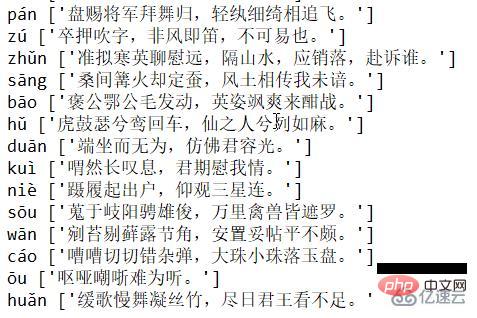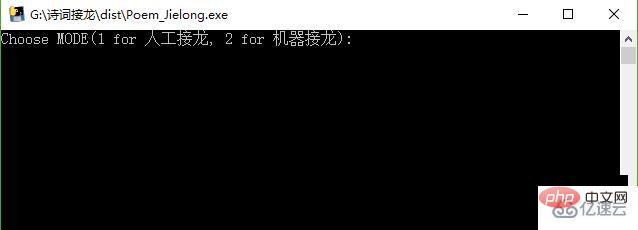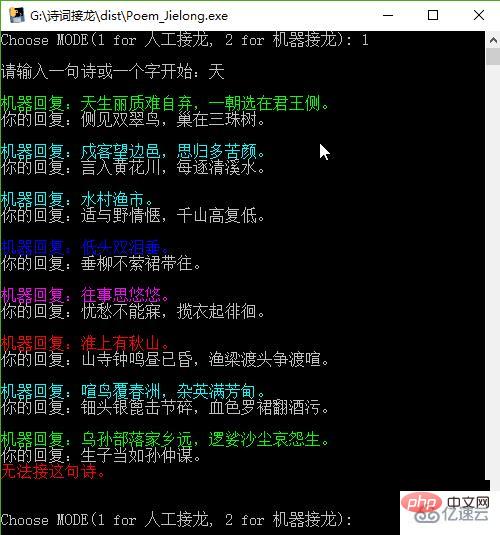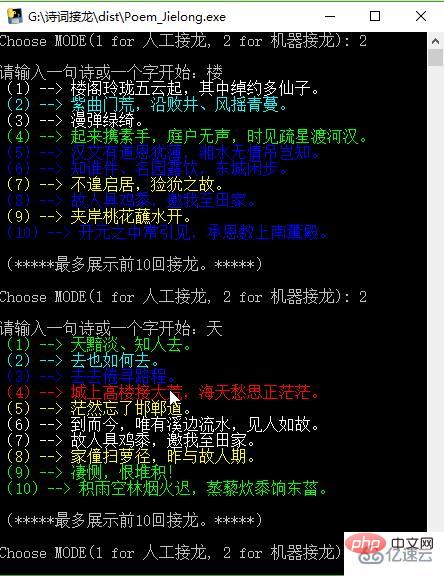How to use Python to write a poetry solitaire program
Poetry Corpus
First, we use a Python crawler to crawl poems and create a corpus. The crawled pages are as follows:

Crawled poems
Since this article is mainly to try to show the ideas of the project, therefore, only the crawled There are 300 Tang poems, 300 ancient poems, 300 Song poems, and selected Song poems on the page, a total of more than 1,100 poems. In order to speed up the crawler, the crawler is implemented concurrently and saved to the poem.txt file. The complete Python program is as follows:
import re
import requests
from bs4 import BeautifulSoup
from concurrent.futures import ThreadPoolExecutor, wait, ALL_COMPLETED
# 爬取的诗歌网址
urls = ['https://so.gushiwen.org/gushi/tangshi.aspx',
'https://so.gushiwen.org/gushi/sanbai.aspx',
'https://so.gushiwen.org/gushi/songsan.aspx',
'https://so.gushiwen.org/gushi/songci.aspx'
]
poem_links = []
# 诗歌的网址
for url in urls:
# 请求头部
headers = {: 'Mozilla/5.0 (Windows NT 10.0; WOW64) AppleWebKit/537.36 (KHTML, like Gecko) Chrome/67.0.3396.87 Safari/537.36'}
req = requests.get(url, headers=headers)
soup = BeautifulSoup(req.text, "lxml")
content = soup.find_all('div', class_="sons")[0]
links = content.find_all('a')
for link in links:
poem_links.append('https://so.gushiwen.org'+link['href'])
poem_list = []
# 爬取诗歌页面
def get_poem(url):
#url = 'https://so.gushiwen.org/shiwenv_45c396367f59.aspx'
# 请求头部
headers = {: 'Mozilla/5.0 (Windows NT 10.0; WOW64) AppleWebKit/537.36 (KHTML, like Gecko) Chrome/67.0.3396.87 Safari/537.36'}
req = requests.get(url, headers=headers)
soup = BeautifulSoup(req.text, "lxml")
poem = soup.find('div', class_='contson').text.strip()
poem = poem.replace(' ', '')
poem = re.sub(re.compile(r"([sS]*?)"), '', poem)
poem = re.sub(re.compile(r"([sS]*?)"), '', poem)
poem = re.sub(re.compile(r"。([sS]*?)"), '', poem)
poem = poem.replace('!', '!').replace('?', '?')
poem_list.append(poem)
# 利用并发爬取
executor = ThreadPoolExecutor(max_workers=10) # 可以自己调整max_workers,即线程的个数
# submit()的参数: 第一个为函数, 之后为该函数的传入参数,允许有多个
future_tasks = [executor.submit(get_poem, url) for url in poem_links]
# 等待所有的线程完成,才进入后续的执行
wait(future_tasks, return_when=ALL_COMPLETED)
# 将爬取的诗句写入txt文件
poems = list(set(poem_list))
poems = sorted(poems, key=lambda x:len(x))
for poem in poems:
poem = poem.replace('《','').replace('》','')
.replace(':', '').replace('“', '')
print(poem)
with open('F://poem.txt', 'a') as f:
f.write(poem)
f.write('
')This program crawls more than 1,100 poems and saves the poems to the poem.txt file to form our poetry corpus. Of course, these poems cannot be used directly, and the data needs to be cleaned. For example, some poems have irregular punctuation, some are not poems, but are just the preface of poems, etc. This process requires manual operation, although it is a little troublesome, but for the subsequent phrasing of the poems The effect is also worth it.
Poetry segmentation
With the poetry corpus, we need to segment the poems. The standard for segmentation is: according to the ending. ? ! For segmentation, this can be achieved using regular expressions. After that, write the poems with good sentences into a dictionary: the key (key) is the pinyin of the first word of the sentence, and the value (value) is the poem corresponding to the pinyin, and save the dictionary as a pickle file. The complete Python code is as follows:
import re
import pickle
from xpinyin import Pinyin
from collections import defaultdict
def main():
with open('F://poem.txt', 'r') as f:
poems = f.readlines()
sents = []
for poem in poems:
parts = re.findall(r'[sS]*?[。?!]', poem.strip())
for part in parts:
if len(part) >= 5:
sents.append(part)
poem_dict = defaultdict(list)
for sent in sents:
print(part)
head = Pinyin().get_pinyin(sent, tone_marks='marks', splitter=' ').split()[0]
poem_dict[head].append(sent)
with open('./poemDict.pk', 'wb') as f:
pickle.dump(poem_dict, f)
main()We can take a look at the contents of the pickle file (poemDict.pk):

Contents of the pickle file (part)
Of course, one pinyin can correspond to multiple poems.
Poetry Solitaire
Read the pickle file, write a program, and run the program as an exe file. In order to avoid errors when compiling the exe file, we need to rewrite the init.py file of the xpinyin module, copy all the code of the file to mypinyin.py, and replace the following code in the code
data_path = os.path.join(os.path.dirname(os.path.abspath(__file__)),
'Mandarin.dat')is rewritten as
data_path = os.path.join(os.getcwd(), 'Mandarin.dat')
so that we complete the mypinyin.py file. Next, we need to write the code for poetry solitaire (Poem_Jielong.py). The complete code is as follows:
import pickle
from mypinyin import Pinyin
import random
import ctypes
STD_INPUT_HANDLE = -10
STD_OUTPUT_HANDLE = -11
STD_ERROR_HANDLE = -12
FOREGROUND_DARKWHITE = 0x07 # 暗白色
FOREGROUND_BLUE = 0x09 # 蓝色
FOREGROUND_GREEN = 0x0a # 绿色
FOREGROUND_SKYBLUE = 0x0b # 天蓝色
FOREGROUND_RED = 0x0c # 红色
FOREGROUND_PINK = 0x0d # 粉红色
FOREGROUND_YELLOW = 0x0e # 黄色
FOREGROUND_WHITE = 0x0f # 白色
std_out_handle = ctypes.windll.kernel32.GetStdHandle(STD_OUTPUT_HANDLE)
# 设置CMD文字颜色
def set_cmd_text_color(color, handle=std_out_handle):
Bool = ctypes.windll.kernel32.SetConsoleTextAttribute(handle, color)
return Bool
# 重置文字颜色为暗白色
def resetColor():
set_cmd_text_color(FOREGROUND_DARKWHITE)
# 在CMD中以指定颜色输出文字
def cprint(mess, color):
color_dict = {
: FOREGROUND_BLUE,
: FOREGROUND_GREEN,
: FOREGROUND_SKYBLUE,
: FOREGROUND_RED,
: FOREGROUND_PINK,
: FOREGROUND_YELLOW,
: FOREGROUND_WHITE
}
set_cmd_text_color(color_dict[color])
print(mess)
resetColor()
color_list = ['蓝色','绿色','天蓝色','红色','粉红色','黄色','白色']
# 获取字典
with open('./poemDict.pk', 'rb') as f:
poem_dict = pickle.load(f)
#for key, value in poem_dict.items():
#print(key, value)
MODE = str(input('Choose MODE(1 for 人工接龙, 2 for 机器接龙): '))
while True:
try:
if MODE == '1':
enter = str(input('
请输入一句诗或一个字开始:'))
while enter != 'exit':
test = Pinyin().get_pinyin(enter, tone_marks='marks', splitter=' ')
tail = test.split()[-1]
if tail not in poem_dict.keys():
cprint('无法接这句诗。
', '红色')
MODE = 0
break
else:
cprint('
机器回复:%s'%random.sample(poem_dict[tail], 1)[0], random.sample(color_list, 1)[0])
enter = str(input('你的回复:'))[:-1]
MODE = 0
if MODE == '2':
enter = input('
请输入一句诗或一个字开始:')
for i in range(10):
test = Pinyin().get_pinyin(enter, tone_marks='marks', splitter=' ')
tail = test.split()[-1]
if tail not in poem_dict.keys():
cprint('------>无法接下去了啦...', '红色')
MODE = 0
break
else:
answer = random.sample(poem_dict[tail], 1)[0]
cprint('(%d)--> %s' % (i+1, answer), random.sample(color_list, 1)[0])
enter = answer[:-1]
print('
(*****最多展示前10回接龙。*****)')
MODE = 0
except Exception as err:
print(err)
finally:
if MODE not in ['1','2']:
MODE = str(input('
Choose MODE(1 for 人工接龙, 2 for 机器接龙): '))Now the structure of the entire project is as follows (the Mandarin.dat file is copied from the folder corresponding to the xpinyin module):

Project file
Switch to the folder and enter the following command to generate the exe file:
pyinstaller -F Poem_jielong.py
The generated exe file is Poem_jielong.exe, located in the dist folder of this folder. In order for the exe to run successfully, the poemDict.pk and Mandarin.dat files need to be copied to the dist folder.
Test run
Run the Poem_jielong.exe file, the page is as follows:

exe file start page
This project There are two modes of Poetry Solitaire. One is manual Solitaire, where you first enter a poem or a word, and then the computer replies with a sentence. You reply with a sentence and are responsible for the rules of Poetry Solitaire; the other mode is machine Solitaire, where you Enter a poem or a word first, and the machine will automatically output the following Solitaire poems (up to 10).Test the manual Solitaire mode first:

artificial Solitaire
Then test the machine Solitaire mode:

The above is the detailed content of How to use Python to write a poetry solitaire program. For more information, please follow other related articles on the PHP Chinese website!

Hot AI Tools

Undress AI Tool
Undress images for free

Undresser.AI Undress
AI-powered app for creating realistic nude photos

AI Clothes Remover
Online AI tool for removing clothes from photos.

Clothoff.io
AI clothes remover

Video Face Swap
Swap faces in any video effortlessly with our completely free AI face swap tool!

Hot Article

Hot Tools

Notepad++7.3.1
Easy-to-use and free code editor

SublimeText3 Chinese version
Chinese version, very easy to use

Zend Studio 13.0.1
Powerful PHP integrated development environment

Dreamweaver CS6
Visual web development tools

SublimeText3 Mac version
God-level code editing software (SublimeText3)
 What are class methods in Python
Aug 21, 2025 am 04:12 AM
What are class methods in Python
Aug 21, 2025 am 04:12 AM
ClassmethodsinPythonareboundtotheclassandnottoinstances,allowingthemtobecalledwithoutcreatinganobject.1.Theyaredefinedusingthe@classmethoddecoratorandtakeclsasthefirstparameter,referringtotheclassitself.2.Theycanaccessclassvariablesandarecommonlyused
 python asyncio queue example
Aug 21, 2025 am 02:13 AM
python asyncio queue example
Aug 21, 2025 am 02:13 AM
asyncio.Queue is a queue tool for secure communication between asynchronous tasks. 1. The producer adds data through awaitqueue.put(item), and the consumer uses awaitqueue.get() to obtain data; 2. For each item you process, you need to call queue.task_done() to wait for queue.join() to complete all tasks; 3. Use None as the end signal to notify the consumer to stop; 4. When multiple consumers, multiple end signals need to be sent or all tasks have been processed before canceling the task; 5. The queue supports setting maxsize limit capacity, put and get operations automatically suspend and do not block the event loop, and the program finally passes Canc
 How to run a Python script and see the output in a separate panel in Sublime Text?
Aug 17, 2025 am 06:06 AM
How to run a Python script and see the output in a separate panel in Sublime Text?
Aug 17, 2025 am 06:06 AM
ToseePythonoutputinaseparatepanelinSublimeText,usethebuilt-inbuildsystembysavingyourfilewitha.pyextensionandpressingCtrl B(orCmd B).2.EnsurethecorrectbuildsystemisselectedbygoingtoTools→BuildSystem→Pythonandconfirming"Python"ischecked.3.Ifn
 How to use regular expressions with the re module in Python?
Aug 22, 2025 am 07:07 AM
How to use regular expressions with the re module in Python?
Aug 22, 2025 am 07:07 AM
Regular expressions are implemented in Python through the re module for searching, matching and manipulating strings. 1. Use re.search() to find the first match in the entire string, re.match() only matches at the beginning of the string; 2. Use brackets() to capture the matching subgroups, which can be named to improve readability; 3. re.findall() returns all non-overlapping matches, and re.finditer() returns the iterator of the matching object; 4. re.sub() replaces the matching text and supports dynamic function replacement; 5. Common patterns include \d, \w, \s, etc., you can use re.IGNORECASE, re.MULTILINE, re.DOTALL, re
 How to build and run Python in Sublime Text?
Aug 22, 2025 pm 03:37 PM
How to build and run Python in Sublime Text?
Aug 22, 2025 pm 03:37 PM
EnsurePythonisinstalledbyrunningpython--versionorpython3--versionintheterminal;ifnotinstalled,downloadfrompython.organdaddtoPATH.2.InSublimeText,gotoTools>BuildSystem>NewBuildSystem,replacecontentwith{"cmd":["python","-
 How to use variables and data types in Python
Aug 20, 2025 am 02:07 AM
How to use variables and data types in Python
Aug 20, 2025 am 02:07 AM
VariablesinPythonarecreatedbyassigningavalueusingthe=operator,anddatatypessuchasint,float,str,bool,andNoneTypedefinethekindofdatabeingstored,withPythonbeingdynamicallytypedsotypecheckingoccursatruntimeusingtype(),andwhilevariablescanbereassignedtodif
 How to pass command-line arguments to a script in Python
Aug 20, 2025 pm 01:50 PM
How to pass command-line arguments to a script in Python
Aug 20, 2025 pm 01:50 PM
Usesys.argvforsimpleargumentaccess,whereargumentsaremanuallyhandledandnoautomaticvalidationorhelpisprovided.2.Useargparseforrobustinterfaces,asitsupportsautomatichelp,typechecking,optionalarguments,anddefaultvalues.3.argparseisrecommendedforcomplexsc
 How to debug a remote Python application in VSCode
Aug 30, 2025 am 06:17 AM
How to debug a remote Python application in VSCode
Aug 30, 2025 am 06:17 AM
To debug a remote Python application, you need to use debugpy and configure port forwarding and path mapping: First, install debugpy on the remote machine and modify the code to listen to port 5678, forward the remote port to the local area through the SSH tunnel, then configure "AttachtoRemotePython" in VSCode's launch.json and correctly set the localRoot and remoteRoot path mappings. Finally, start the application and connect to the debugger to realize remote breakpoint debugging, variable checking and code stepping. The entire process depends on debugpy, secure port forwarding and precise path matching.







